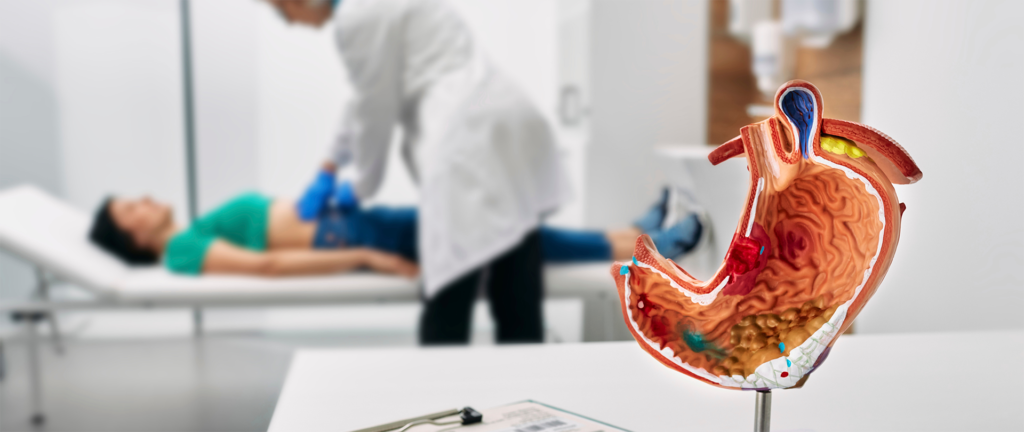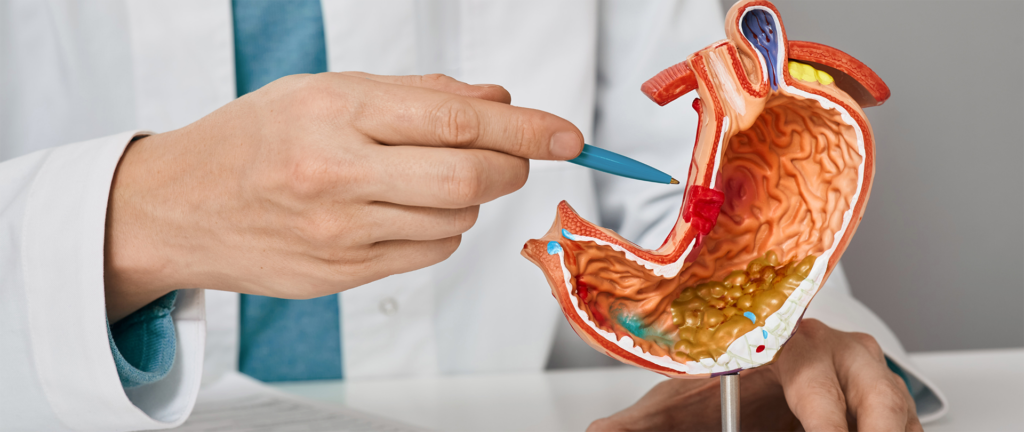Gastroenterology
Maybe you’ve had a stomachache for a while, or you constantly feel bloated after eating. You’re troubled by heartburn, or you’ve suddenly lost your appetite, and your primary doctor hasn’t been able to help. Perhaps you’ve suddenly experienced cramps, pain under the right rib or in the lower abdomen, nausea, or difficulty swallowing. Or maybe you’ve already been diagnosed with acid reflux, irritable bowel syndrome, hepatitis, or Crohn’s disease, and you want a second opinion, which makes you part of the 30% of the adult population in Serbia suffering from some kind of gastrointestinal disorder. Many of you, however, don’t seek medical help immediately, but instead take over-the-counter medications or consult pharmacists to ease the symptoms, which can lead to complications later on.
There are many reasons why you may need to see a gastroenterology specialist, an expert who diagnoses and treats diseases of the gastrointestinal system responsible for digesting food and absorbing nutrients. This includes the esophagus, stomach, small and large intestines, liver, pancreas, and gallbladder.
Symptoms That Require a Gastroenterologist
If you notice any of these symptoms, you should see a gastroenterologist. These symptoms can be caused by various conditions and do not necessarily mean you have a gastrointestinal disease, but they definitely require further diagnostics:
Persistent stomach pain – Whether continuous or recurring, unexplained, sharp or dull, stomach pain that interferes with your daily activities can indicate a problem with the digestive system.
Heartburn or acid reflux – Frequent or severe burning sensations in the chest or acid coming back up from the stomach into the esophagus may be signs of gastroesophageal reflux disease (GERD), which requires careful treatment.
Chronic diarrhea or constipation – Changes in bowel habits such as frequent diarrhea or constipation, especially if they last for a long time or begin suddenly and inexplicably, should be assessed by a gastroenterologist.
Bloating and gas – Persistent bloating, a feeling of heaviness in the stomach, or excessive gas can indicate an underlying gastrointestinal issue.
Gastrointestinal bleeding – Blood in the stool (hematochezia), whether bright red or black and tar-like (melena), can be a sign of serious conditions such as hemorrhoids, polyps, or ulcers.
Unexplained weight loss – Weight loss that cannot be explained by changes in diet or physical activity may indicate an underlying gastrointestinal problem.
Difficulty swallowing – If you feel pain or discomfort when swallowing food or drinks (dysphagia), or if you feel that food is stuck in your throat or chest, this may indicate an issue with the esophagus or upper digestive tract.
Jaundice – Yellowing of the skin and eyes may indicate problems with the liver or gallbladder.
Persistent nausea and vomiting or the urge to vomit without a clear reason – Especially if accompanied by other symptoms such as stomach pain or weight loss, this is a sign that you need a specialist examination.
Changes in appetite – A reduced appetite or feeling full after a small amount of food is a symptom that needs attention.
Family history of gastrointestinal diseases – Such as colon cancer, inflammatory bowel disease (IBD), or celiac disease requires regular preventive check-ups.
Diagnoses That Can Be Made Through Gastroenterological Examinations
Gastroenterological examinations cover a wide range of diagnostic methods that help diagnose numerous conditions related to the digestive system. Here are some of the most common diagnoses that can be made through these examinations:
Gastroesophageal reflux disease (GERD)
Often diagnosed using endoscopy or esophageal pH monitoring, if abnormal cell structures are detected on the esophagus wall or traces of acid presence are found.
Stomach or duodenal ulcers
Diagnosed through gastroscopy, an endoscopic examination of the upper digestive tract, or other imaging techniques.
Helicobacter pylori infection
Can be diagnosed through blood, breath tests, or biopsy samples taken during endoscopy.
Inflammatory bowel disease (IBD)
Conditions like Crohn’s disease and ulcerative colitis are usually diagnosed by assessing symptoms, colonoscopy, and biopsy.
Irritable bowel syndrome (IBS)
Diagnosed by excluding other diseases and assessing symptoms, often with the help of colonoscopy or other tests.
Gastrointestinal bleeding
Can be detected through a combination of procedures, such as gastroscopy, colonoscopy, or capsule endoscopy, to identify the source and cause of bleeding.
Celiac disease
Diagnosed through blood tests for specific antibodies and small intestine biopsy taken during gastroscopy to confirm damage to the intestinal lining.
Intestinal polyps
Detected during colonoscopy and can be removed during the examination.
Gastrointestinal tract tumors
Gastroenterological examinations such as endoscopy, colonoscopy, biopsy, ultrasound, and CT scans can help detect various types of tumors, including those in the esophagus, stomach, colorectum, pancreas, and liver.
Diverticulosis and diverticulitis
Pockets formed on the wall of the large intestine, which can become inflamed, detected through colonoscopy or CT scan.
Gallbladder and bile duct disorders
Diagnosed through ultrasound, CT scan, or ERCP (endoscopic retrograde cholangiopancreatography) to detect gallstones, cholecystitis, and bile duct obstructions.
Pancreatic disorders
Acute or chronic inflammation of the pancreas, pancreatic cysts, and pancreatic cancer are diagnosed through symptom assessment, blood tests, ultrasound, CT scan, and biopsy.
Liver diseases
Various liver conditions such as hepatitis, cirrhosis, fatty liver disease, and liver tumors are diagnosed through blood tests, ultrasound imaging, or liver biopsy.
Why Choose the Gastroenterology Team at PULS DEDINJE?
At the PULS DEDINJE Internal Medicine Hospital, patients have access to the most advanced diagnostic and treatment methods for diseases and functional disorders of the digestive organs. In addition to comprehensive laboratory diagnostics, a team of top gastroenterologists is available, dealing with a wide range of conditions – from digestive issues and irritable bowel syndrome to more serious conditions such as inflammatory bowel disease, liver cirrhosis, and digestive system malignancies.
Patients are also offered various diagnostic and therapeutic procedures such as endoscopy, colonoscopy, and ultrasound to identify the causes of symptoms and develop effective treatment plans.
The head of the gastroenterology team is Assistant Dr. Sci. Med. Vladimir Milivojević, a gastroenterologist-hepatologist, an expert oriented towards all aspects of clinical gastroenterology and hepatology, performing interventional and therapeutic procedures – removing polyps from the stomach, duodenum, and colon, as well as the most complex endoscopic ERCP procedure for diagnosing and treating bile ducts, the main pancreatic duct, removing gallstones from the bile ducts, and placing stents in cases of tumors of the bile ducts and pancreatic ducts.

What does a gastroenterological examination entail?
The main purpose of a gastroenterological examination is to investigate and diagnose various gastrointestinal disorders and diseases such as gastroesophageal reflux disease (GERD), peptic ulcers, inflammatory bowel disease (Crohn’s disease and ulcerative colitis), irritable bowel syndrome (IBS), gastrointestinal bleeding, liver diseases, and pancreatic disorders, among others.
The examination includes different techniques depending on the symptoms and suspected disorder. Common gastroenterological exams include taking a patient’s medical history, a physical abdominal exam, ultrasound, endoscopy, colonoscopy, as well as various laboratory tests. During the examination, our gastroenterologists assess whether additional diagnostics are needed and then decide on the necessary therapy, which the patient can receive either as an outpatient or in a hospital setting. The patient is carefully monitored from the first examination, throughout the entire treatment process, and even after discharge from the hospital – until full recovery.
Types of Gastroenterological Examinations
Gastroenterological examinations include various diagnostic procedures that help in detecting and monitoring diseases of the digestive system. The specific type of examination recommended will depend on the patient’s symptoms and medical history. Each examination has its advantages and limitations, and the choice of procedure will be determined by the gastroenterologist in consultation with the patient. Here are the most common types of gastroenterological examinations:
1. X-ray
– A standard abdominal X-ray shows the structure of digestive organs and identifies obstructions and abnormalities such as intestinal distension, gallstones, accumulation of gases, fluids…
– A contrast X-ray (barium) is used for a more detailed examination of the digestive system. The patient drinks a liquid containing barium, a contrast medium that allows the stomach, small intestine, and colon to be better visualized on the X-ray. This method helps in diagnosing ulcers, tumors, reflux, and obstructions. Barium meal (upper gastrointestinal series): Used to examine the esophagus, stomach, and duodenum. Barium enema: Used to examine the colon and rectum.
2. Endoscopy
– Gastroscopy: Examination of the upper part of the digestive tract (esophagus, stomach, and duodenum) using a thin flexible tube with a camera (endoscope). It is used to diagnose ulcers, inflammation, reflux, and tumors.
– Colonoscopy: Examination of the entire colon using an endoscope. It is used to detect polyps, inflammatory bowel diseases, colorectal cancer, and diverticulosis.
– Rectoscopy and Sigmoidoscopy: Examination of the rectum and the lower part of the colon, usually used to detect hemorrhoids, anal fissures, polyps, and tumors.
3. Capsule Endoscopy
– The patient swallows a capsule with a camera that takes pictures of the intestines as it passes through the digestive tract. This method is useful for examining the small intestine, which is harder to access using standard methods.
4. Abdominal Ultrasound
– A non-invasive method for imaging abdominal organs, including the liver, gallbladder, pancreas, and spleen. It is used to detect gallstones, tumors, cysts, inflammation, and organ damage.
5. ERCP (Endoscopic Retrograde Cholangiopancreatography)
– A combination of endoscopy and X-ray used to examine bile ducts, the pancreas, and the liver. This method can remove stones from bile ducts or take tissue samples.
6. Helicobacter pylori Tests
– Various tests (blood, breath, stool, biopsy) are used to diagnose an infection with Helicobacter pylori, which is associated with stomach and duodenal ulcers.
7. Biopsy
– During endoscopy or colonoscopy, a tissue sample is taken for microscopic examination. Biopsies are used to diagnose cancer, celiac disease, inflammatory bowel diseases, and other conditions.
8. Liver Function Tests
– Blood tests measure enzyme levels, bilirubin, and proteins to assess liver function and detect disorders such as hepatitis, cirrhosis, or fatty liver.
9. Esophageal Manometry
– A test that measures pressure in the esophagus and helps diagnose swallowing problems or acid reflux.
10. Esophageal pH Monitoring
– A test that measures the amount of acid in the esophagus over 24 hours to assess gastroesophageal reflux disease (GERD).
11. CT Scan
– This method is used to image the abdominal organs, often when there is suspicion of tumors, inflammation of the pancreas, liver diseases, and other serious conditions.
12. Color Doppler Ultrasound
– A specialized ultrasound exam shows blood flow through the abdominal blood vessels, useful for diagnosing problems with the liver, spleen, or pancreas.
13. Endoscopic Ultrasound (EUS)
An endoscope with an attached ultrasound probe is used for the examination. It provides detailed images of the digestive tract and surrounding organs, such as the pancreas, liver, and lymph nodes. EUS is useful for diagnosing and assessing the stage of gastrointestinal tract cancers and for evaluating conditions such as pancreatic cysts and bile duct abnormalities.
14. Flexible Sigmoidoscopy
Involves inserting a flexible tube with a camera (sigmoidoscope) into the rectum and lower part of the colon. It is used to examine the rectum and left side of the colon for conditions such as polyps, inflammation, and bleeding.

How are the most common gastroenterological examinations performed?
Gastroscopy
Preparation: The patient receives instructions on what they are allowed to eat a few days before the procedure, as well as the night before. They may also need to stop taking certain medications.
Procedure: The patient is given a sedative to help them relax. A thin, flexible tube with a camera (endoscope) is inserted through the mouth into the esophagus, stomach, and the upper part of the small intestine. The gastroenterologist carefully maneuvers the endoscope while examining the lining of the digestive tract and capturing images.
Duration: The procedure usually lasts 10–20 minutes.
Colonoscopy
Preparation: The patient receives instructions on how to clean the colon before the procedure. This usually involves a liquid diet and taking laxatives or medications to empty the bowels.
Procedure: The patient is given a sedative to relax. A long, flexible tube with a camera (colonoscope) is inserted through the rectum and gradually advanced through the entire colon. The gastroenterologist examines the lining of the colon, looks for abnormalities, and can take biopsies or remove polyps if necessary.
Duration: The procedure usually lasts around 30 minutes to an hour.
Capsule Endoscopy
Preparation: The patient is usually required to follow a specific diet for some time before the procedure.
Procedure: The patient swallows a small capsule containing a camera. As the capsule passes through the digestive tract, it captures images of the intestinal lining. The patient wears a data recorder on a belt, which receives and records the images for later review by the gastroenterologist.
Duration: The capsule takes about 8 hours to pass through the entire digestive tract.
The course of treatment for gastroenterological diseases
After completing the diagnostic examinations in gastroenterology, the next steps depend on the results of the exams and the diagnosis. Here’s how the process usually unfolds:
Reviewing results: When the doctor receives the diagnostic test results (X-rays, endoscopy, blood tests, etc.), they carefully examine them to determine if there is a problem in the digestive system. In some cases, the results are available immediately (as with endoscopy), while for other tests, such as biopsy, it may take a few days.
Establishing a diagnosis: Based on the results, the gastroenterologist makes a diagnosis. Diagnoses can range from simple conditions like gastritis or reflux to more serious diseases such as inflammatory bowel disease, tumors, or cirrhosis.
Explaining the diagnosis to the patient: The doctor will explain the diagnosis in detail, including causes, symptoms, potential complications, and how the condition may affect your daily life.
Reviewing treatment options: The doctor will present treatment options, which may include changes in diet, medications, lifestyle changes, or in more severe cases, surgical procedures.
Prescribing treatment: If the condition can be treated with medications, the doctor will prescribe appropriate medications such as:
- Antacids or proton pump inhibitors to reduce stomach acid (for GERD or ulcers).
- Antibiotics to treat infections such as Helicobacter pylori.
- Corticosteroids or immunomodulators for inflammatory bowel diseases such as Crohn’s disease or ulcerative colitis.
- Laxatives or medications to regulate bowel movements in cases of constipation or irritable bowel syndrome.
Dietary changes: The doctor may recommend specific dietary changes depending on the diagnosis. For example:
- Gluten-free diet for patients with celiac disease.
- High-fiber diet for constipation or irritable bowel syndrome.
- Avoiding certain foods for patients with reflux or gastritis.
Lifestyle changes: Recommendations may include quitting smoking, reducing alcohol intake, regular physical activity, and stress reduction techniques, as all of these can positively affect the digestive system.
Follow-up exams and monitoring: For chronic conditions or conditions requiring prolonged treatment, the doctor will schedule follow-up appointments to monitor your progress and respond to any changes. In some cases, repeat diagnostic exams (such as colonoscopy or endoscopy) may be necessary to assess the effectiveness of treatment or to monitor disease progression.
Surgical procedures (if necessary): In more severe cases, when medications and lifestyle changes are insufficient to control symptoms or cure the condition, surgery may be recommended. Some of the most common surgical procedures in gastroenterology include:
- Surgical removal of polyps or tumors detected during colonoscopy.
- Hernia repair or surgery for acid reflux (fundoplication).
- Bowel surgery for inflammatory bowel diseases (e.g., removing damaged sections of the bowel in Crohn’s disease).
- Liver transplant for severe cirrhosis.
The gastroenterologist will provide all the necessary information about your condition and treatment options. They may also refer patients to a dietitian, physiotherapist, or psychologist, depending on individual needs. For chronic diseases, patients often receive brochures, self-help guidelines, and information about patient support groups and counseling. For patients with chronic conditions such as inflammatory bowel disease or liver cirrhosis, monitoring may be long-term, with regular visits to the gastroenterologist and periodic adjustments to the therapy. The goal of this process is not only to establish an accurate diagnosis but also to provide appropriate therapy and long-term care to improve the patient’s health and maintain their quality of life.

When is it necessary to schedule a gastroenterological examination?
If you have persistent gastrointestinal symptoms or a family history of digestive disorders, it is essential to undergo regular gastroenterological check-ups. If any gastrointestinal symptom lasts longer than a few weeks or significantly affects your quality of life, you should schedule an appointment with a gastroenterologist to get an accurate diagnosis and start treatment.
Early detection and intervention can lead to more effective treatment outcomes and an improved quality of life. So, don’t delay—be proactive about your digestive health. Schedule a gastroenterological examination today and take an essential step towards understanding and improving your health.
You can view the prices of gastroenterological examinations in our price list.
